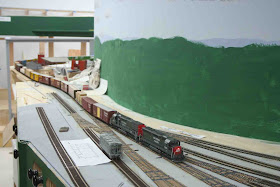The national convention of the National Model Railroad
Association (NMRA) just concluded its 2015 edition in Portland, OR, August
23-30. I have been aiming at
supporting this convention and showing off my layout for it for the past three
years. This was THE BIG
EVENT!!!
When I began this blog and then actual layout construction,
beginning August 1, 2012, I expected there would be another NMRA national
convention in Portland sometime in my lifetime. That probability became part of our lot selection criteria,
as the formal layout tours for such events are conducted with 50 passenger tour
buses. We needed easy bus access
and good street parking for such tours.
About two months after starting construction, I learned that Portland
would, indeed, host another NMRA national, but that it was a scant three years
in the future! Yikes!!! This was my one shot at presenting my
layout and its design and operations ideas to a national audience. As readers of this blog have seen, that
led to very focused work and ultimate success—just in time.
I hosted three separate activities with the layout during
the convention. On Tuesday
afternoon, we had the formal convention bus tours. Two 50-passenger buses came by, filled out to capacity due
to at least one of the other layouts on the tour. My helping crew and I barely had time to grab a quick dinner
before the second event. Fifteen
guys signed up for an operating session—the fourth using the full
mainline. Finally, Wednesday was the
traditional day for the Layout Design Special Interest Group (LDSIG) layout
tour. As local LDSIG Convention
Coordinator, I had arranged to have 17 layouts on the tour, including my own. Following that, it was back to the
convention in Portland.
The following photos represent the first set of photos from
those activities. Most of these
images were shot with my camera by one of my helping crew. A subsequent post will provide more
coverage. Meanwhile, this post
marks my one hundredth post—a fitting way to reach that milestone.
Formal NMRA convention bus tour visitors arriving.
A poster and handout explained the layout concept.
Tour visitors roamed the aisles while my helping crew ran
trains and answered questions. I
was stationed near the basement entrance, greeting visitors and answering questions.
The aisles could get a bit crowded, but the visitors were
able to move around.
Stay tuned for a subsequent post covering the operating
session. Meanwhile, I will attempt
to take a break from railroading following the intense effort to build and
prepare the layout for all of this.
Three years from bare basement to functioning monster layout completely
built by me, alone. That
construction effort was accompanied by doing the local coordinator work for the
Layout Design and Operations Special Interest Groups. Time for a rest!




































